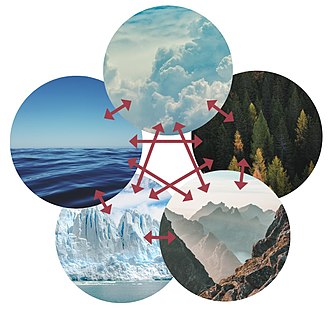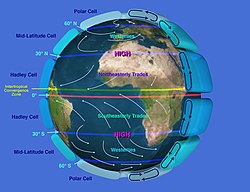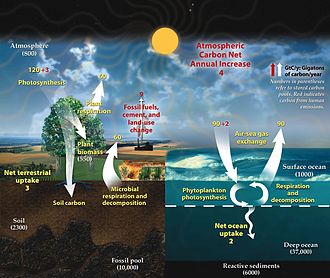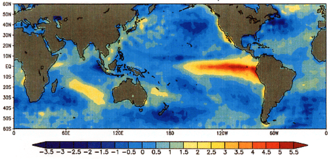Climate system

Earth's climate system is a
The climate system can change due to
Components
The atmosphere envelops the earth and extends hundreds of kilometres from the surface. It consists mostly of inert
The
The hydrosphere proper contains all the liquid water on Earth, with most of it contained in the world's oceans.[8] The ocean covers 71% of Earth's surface to an average depth of nearly 4 kilometres (2.5 miles),[9] and ocean heat content is much larger than the heat held by the atmosphere.[10][11] It contains seawater with a salt content of about 3.5% on average, but this varies spatially.[9] Brackish water is found in estuaries and some lakes, and most freshwater, 2.5% of all water, is held in ice and snow.[12]
The
The Earth's crust, specifically mountains and valleys, shapes global wind patterns: vast mountain ranges form a barrier to winds and impact where and how much it rains.[15][16] Land closer to open ocean has a more moderate climate than land farther from the ocean.[17] For the purpose of modelling the climate, the land is often considered static as it changes very slowly compared to the other elements that make up the climate system.[18] The position of the continents determines the geometry of the oceans and therefore influences patterns of ocean circulation. The locations of the seas are important in controlling the transfer of heat and moisture across the globe, and therefore, in determining global climate.[19]
Lastly, the biosphere also interacts with the rest of the climate system.
Flows of energy, water and elements

Energy and general circulation
The climate system receives energy from the Sun, and to a far lesser extent from the Earth's core, as well as tidal energy from the Moon. The Earth gives off energy to outer space in two forms: it directly reflects a part of the radiation of the Sun and it emits infra-red radiation as
More energy reaches the tropics than the polar regions and the subsequent temperature difference drives the global circulation of the
Ocean water that has more salt has a higher
Hydrological cycle
The hydrological cycle or water cycle describes how it is constantly moved between the surface of the Earth and the atmosphere.[33] Plants evapotranspirate and sunlight evaporates water from oceans and other water bodies, leaving behind salt and other minerals. The evaporated freshwater later rains back onto the surface.[34] Precipitation and evaporation are not evenly distributed across the globe, with some regions such as the tropics having more rainfall than evaporation, and others having more evaporation than rainfall.[35] The evaporation of water requires substantial quantities of energy, whereas a lot of heat is released during condensation. This latent heat is the primary source of energy in the atmosphere.[36]
Biochemical cycles

Chemical elements, vital for life, are constantly cycled through the different components of the climate system. The
The
Changes within the climate system
Climate is constantly varying, on timescales that range from seasons to the lifetime of the Earth.
Internal variability

Components of the climate system vary continuously, even without external pushes (external forcing). One example in the atmosphere is the
The ocean and atmosphere can also work together to spontaneously generate internal climate variability that can persist for years to decades at a time.[53][54] Examples of this type of variability include the El Niño–Southern Oscillation, the Pacific decadal oscillation, and the Atlantic Multidecadal Oscillation. These variations can affect global average surface temperature by redistributing heat between the deep ocean and the atmosphere;[55][56] but also by altering the cloud, water vapour or sea ice distribution, which can affect the total energy budget of the earth.[57][58]
The oceanic aspects of these oscillations can generate variability on centennial timescales due to the ocean having hundreds of times more mass than the
External climate forcing
On long timescales, the climate is determined mostly by how much energy is in the system and where it goes. When the Earth's energy budget changes, the climate follows. A change in the energy budget is called a forcing, and when the change is caused by something outside of the five components of the climate system, it is called an external forcing.[60] Volcanoes, for example, result from deep processes within the earth that are not considered part of the climate system. Off-planet changes, such as solar variation and incoming asteroids, are also "external" to the climate system's five components, as are human actions.[61]
The main value to quantify and compare climate forcings is radiative forcing.
Incoming sunlight
The
Slight variations in the Earth's motion can cause large changes in the seasonal distribution of sunlight reaching the Earth's surface and how it is distributed across the globe, although not to the global and yearly average sunlight. The three types of
Greenhouse gases
Greenhouse gases trap heat in the lower part of the atmosphere by absorbing
Aerosols
Liquid and solid particles in the atmosphere, collectively named aerosols, have diverse effects on the climate. Some primarily scatter sunlight and thereby cool the planet, while others absorb sunlight and warm the atmosphere.
Although volcanoes are technically part of the lithosphere, which itself is part of the climate system, volcanism is defined as an external forcing agent.
Land use and cover change
Changes in land cover, such as change of water cover (e.g.
Responses and feedbacks

The different elements of the climate system respond to external forcing in different ways. One important difference between the components is the speed at which they react to a forcing. The atmosphere typically responds within a couple of hours to weeks, while the deep ocean and ice sheets take centuries to millennia to reach a new equilibrium.[82]
The initial response of a component to an external forcing can be
References
- ^ a b c Planton 2013, p. 1451.
- ^ Planton 2013, p. 1450.
- ^ "Climate systems". climatechange.environment.nsw.gov.au. Archived from the original on 2019-05-06. Retrieved 2019-05-06.
- ^ "Earth's climate system". World Ocean Review. Retrieved 2019-10-13.
- ^ Barry & Hall-McKim 2014, p. 22; Goosse 2015, section 1.2.1.
- ^ Gettelman & Rood 2016, pp. 14–15.
- ^ Gettelman & Rood 2016, p. 16.
- ^ Kundzewicz 2008.
- ^ a b Goosse 2015, p. 11.
- ^ Gettelman & Rood 2016, p. 17.
- ^ "Vital Signs of the Plant: Ocean Heat Content". NASA. Retrieved 2022-02-12.
- ^ Desonie 2008, p. 4.
- ^ Goosse 2015, p. 20.
- ^ Goosse 2015, p. 22.
- ^ Goosse 2015, p. 25.
- ^ Houze 2012.
- ^ Barry & Hall-McKim 2014, pp. 135–137.
- ^ Gettelman & Rood 2016, pp. 18–19.
- ^ Haug & Keigwin 2004.
- ^ a b Gettelman & Rood 2016, p. 19.
- ^ Goosse 2015, p. 26.
- ^ Goosse 2015, p. 28.
- ^ Smil 2003, p. 133.
- ^ Barry & Hall-McKim 2014, p. 101.
- ^ Barry & Hall-McKim 2014, pp. 15–23.
- ^ Bridgman & Oliver 2014, p. 131.
- ^ Barry & Hall-McKim 2014, p. 95.
- ^ Barry & Hall-McKim 2014, pp. 95–97.
- ^ Gruza 2009, pp. 124–125.
- ^ Goosse 2015, p. 18.
- ^ Goosse 2015, p. 12.
- ^ Goosse 2015, p. 13.
- ^ "The water cycle". Met Office. Retrieved 2019-10-14.
- ^ Brengtsson et al. 2014, p. 6.
- ^ Peixoto 1993, p. 5.
- ^ Goosse 2015, section 2.2.1.
- ^ Goosse 2015, section 2.3.1.
- ^ Möller 2010, pp. 123–125.
- ^ Aiuppa et al. 2006.
- ^ Riebeek, Holli (16 June 2011). "The Carbon Cycle". Earth Observatory. NASA.
- ^ Möller 2010, pp. 128–129.
- ^ Möller 2010, pp. 129, 197.
- ^ National Research Council 2001, p. 8.
- ^ Nath et al. 2018.
- ^ Australian Academy of Science (2015). "1. What is climate change?". www.science.org.au. The science of climate change - Questions and Answers. Retrieved 2019-10-20.
- ^ National Geographic (2019-03-28). "Climate Change". Retrieved 2019-10-20.
- ^ Mauritsen et al. 2013.
- ^ Carlowicz, Mike; Uz, Stephanie Schollaert (14 February 2017). "El Niño: Pacific Wind and Current Changes Bring Warm, Wild Weather". Earth Observatory. NASA.
- ^ "North Atlantic Oscillation". Met Office. Retrieved 2019-10-03.
- ^ Chiodo et al. 2019.
- ^ Olsen, Anderson & Knudsen 2012.
- ^ Delworth et al. 2016.
- ^ Brown et al. 2015.
- ^ Hasselmann 1976.
- ^ Meehl et al. 2013.
- ^ England et al. 2014.
- ^ Brown et al. 2014.
- ^ Palmer & McNeall 2014.
- ^ Wallace et al. 2013.
- ^ Gettelman & Rood 2016, p. 23.
- ^ Planton 2013, p. 1454: "External forcing refers to a forcing agent outside the climate system causing a change in the climate system. Volcanic eruptions, solar variations and anthropogenic changes in the composition of the atmosphere and land use change are external forcings. Orbital forcing is also an external forcing as the insolation changes with orbital parameters eccentricity, tilt and precession of the equinox."
- ^ Roy 2018, p. xvii.
- ^ Willson & Hudson 1991.
- ^ Turner et al. 2016.
- ^ Roy 2018, pp. xvii–xviii.
- ^ "Milankovitch Cycles and Glaciation". University of Montana. Archived from the original on 2011-07-16. Retrieved 2 April 2009.
- ^ McMichael, Woodruff & Hales 2006.
- ^ Schmidt et al. 2010.
- ^ Liu, Dreybrodt & Liu 2011.
- ^ a b Myhre et al. 2013.
- ^ Lohmann & Feichter 2005.
- ^ Samset 2018.
- ^ Man, Zhou & Jungclaus 2014.
- ^ a b Miles, Grainger & Highwood 2004.
- ^ Graf, Feichter & Langmann 1997.
- ^ Jones, Collins & Torn 2013.
- ^ Tosca, Randerson & Zender 2013.
- ^ Kerr 2013.
- ^ "The Study of Earth as an Integrated System". nasa.gov. NASA. 2016. Archived from the original on November 2, 2016.
- ^ Fig. TS.17, Technical Summary, Sixth Assessment Report (AR6), Working Group I, IPCC, 2021, p. 96. Archived from the original on July 21, 2022.
- ^ Stocker, Thomas F.; Dahe, Qin; Plattner, Gian-Kaksper (2013). IPCC AR5 WG1. Technical Summary (PDF). Archived (PDF) from the original on 16 July 2023. See esp. TFE.6: Climate Sensitivity and Feedbacks at p. 82.
- ^ Ruddiman 2001, pp. 10–12.
- ^ Ruddiman 2001, pp. 16–17.
Sources
- Aiuppa, A.; Federico, C.; Giudice, G.; Gurrieri, S.; Liuzzo, M.; Shinohara, H.; Favara, R.; Valenza, M. (2006). "Rates of carbon dioxide plume degassing from Mount Etna volcano". Journal of Geophysical Research. 111 (B9): B09207. .
- Barry, Roger G.; Hall-McKim, Eileen A. (2014). Essentials of the Earth's Climate System. Cambridge University Press. ISBN 978-1-107-03725-0.
- Brengtsson, L.; Bonnet, R.-M.; Calisto, M.; Destouni, G. (2014). The Earth's Hydrological Cycle. ISSI. ISBN 978-94-017-8788-8.
- Bridgman, Howard A.; Oliver, John. E. (2014). The Global Climate System: Patterns, Processes, and Teleconnections. Cambridge University Press. ISBN 978-1-107-66837-9.
- Brown, Patrick T.; Li, Wenhong; Li, Laifang; Ming, Yi (28 July 2014). "Top-of-atmosphere radiative contribution to unforced decadal global temperature variability in climate models". Geophysical Research Letters. 41 (14): 5175–5183. S2CID 16933795.
- Brown, Patrick T.; Li, Wenhong; Cordero, Eugene C.; Mauget, Steven A. (21 April 2015). "Comparing the model-simulated global warming signal to observations using empirical estimates of unforced noise". Scientific Reports. 5 (1): 9957. PMID 25898351.
- Chiodo, Gabriel; Oehrlein, Jessica; Polvani, Lorenzo M.; Fyfe, John C.; Smith, Anne K. (21 January 2019). "Insignificant influence of the 11-year solar cycle on the North Atlantic Oscillation". Nature Geoscience. 12 (2): 94–99. S2CID 133676608.
- Delworth, Thomas L.; Zeng, Fanrong; Vecchi, Gabriel A.; Yang, Xiaosong; Zhang, Liping; Zhang, Rong (20 June 2016). "The North Atlantic Oscillation as a driver of rapid climate change in the Northern Hemisphere". Nature Geoscience. 9 (7): 509–512. doi:10.1038/ngeo2738.
- Desonie, Dana (2008). Hydrosphere: Freshwater Systems and Pollution (Our Fragile Planet): Fresh Water Systems and Pollution. Chelsea House books. ISBN 9780816062157.
- England, Matthew H.; McGregor, Shayne; Spence, Paul; Meehl, Gerald A.; .
- Gettelman, Andrew; Rood, Richard B. (2016). "Components of the Climate System". Demystifying Climate Models. Earth Systems Data and Models. Vol. 2. pp. 13–22. ISBN 978-3-662-48957-4.
- Goosse, Hugues (2015). Climate System Dynamics and Modelling. New York: Cambridge University Press. ISBN 978-1-107-08389-9.
- Graf, H.-F.; Feichter, J.; Langmann, B. (1997). "Volcanic sulphur emissions: Estimates of source strength and its contribution to the global sulphate distribution". Journal of Geophysical Research: Atmospheres. 102 (D9): 10727–38. .
- Gruza, George Vadimovich (2009). Environmental Structure And Function: Climate System - Volume I. EOLSS Publications. ISBN 978-1-84826-738-1.
- Hasselmann, K. (December 1976). "Stochastic climate models Part I. Theory". Tellus. 28 (6): 473–485. .
- Haug, Gerald H.; Keigwin, Lloyd D. (22 March 2004). "How the Isthmus of Panama Put Ice in the Arctic". Oceanus. 42 (2). Woods Hole Oceanographic Institution.
- Houze, Robert A. (6 January 2012). "Orographic effects on precipitating clouds". Reviews of Geophysics. 50 (1): RG1001. S2CID 46645620.
- Kerr, Richard A. (2013-01-25). "Soot Is Warming the World Even More Than Thought". Science. 339 (6118): 382. PMID 23349261.
- Jones, Andrew D.; Collins, William D.; S2CID 128670263.
- Kundzewicz, Zbigniew W. (January 2008). "Climate change impacts on the hydrological cycle". Ecohydrology & Hydrobiology. 8 (2–4): 195–203. S2CID 15552176.
- Liu, Zaihua; Dreybrodt, Wolfgang; Liu, Huan (June 2011). "Atmospheric CO2 sink: Silicate weathering or carbonate weathering?". Applied Geochemistry. 26: S292–S294. .
- Lohmann, U.; Feichter, J. (2005). "Global indirect aerosol effects: a review" (PDF). Atmospheric Chemistry and Physics. 5 (3): 715–737. .
- Man, Wenmin; Zhou, Tianjun; Jungclaus, Johann H. (October 2014). "Effects of Large Volcanic Eruptions on Global Summer Climate and East Asian Monsoon Changes during the Last Millennium: Analysis of MPI-ESM Simulations". Journal of Climate. 27 (19): 7394–7409. S2CID 128676242.
- Mauritsen, Thorsten; Graversen, Rune G.; Klocke, Daniel; Langen, Peter L.; Stevens, Bjorn; Tomassini, Lorenzo (29 May 2013). "Climate feedback efficiency and synergy". Climate Dynamics. 41 (9–10): 2539–2554. .
- McMichael, Anthony J; Woodruff, Rosalie E; Hales, Simon (March 2006). "Climate change and human health: present and future risks". The Lancet. 367 (9513): 859–869. S2CID 11220212.
- Meehl, Gerald A.; Hu, Aixue; Arblaster, Julie M.; Fasullo, John; Trenberth, Kevin E. (September 2013). "Externally Forced and Internally Generated Decadal Climate Variability Associated with the Interdecadal Pacific Oscillation". Journal of Climate. 26 (18): 7298–7310. S2CID 16183172.
- Miles, M.G.; Grainger, R.G.; Highwood, E.J. (2004). "The significance of volcanic eruption strength and frequency for climate". Quarterly Journal of the Royal Meteorological Society. 130 (602): 2361–76. S2CID 53005926.
- Möller, Detlev (2010). Chemistry of the Climate System. de Gruyter. ISBN 978-3-11-019791-4.
- Myhre, Gunman; Lund Myhre, Catherine; Samset, Bjorn; Storelvmo, Trude (2013). "Aerosols and their Relation to Global Climate and Climate Sensitivity". Nature Education. 5.
- Nath, Reshmita; Luo, Yong; Chen, Wen; Cui, Xuefeng (21 December 2018). "On the contribution of internal variability and external forcing factors to the Cooling trend over the Humid Subtropical Indo-Gangetic Plain in India". Scientific Reports. 8 (1): 18047. PMID 30575779.
- National Research Council (2001). "Natural Climatic Variations". Climate Change Science. p. 8. ISBN 978-0-309-07574-9.
- Olsen, Jesper; Anderson, N. John; Knudsen, Mads F. (23 September 2012). "Variability of the North Atlantic Oscillation over the past 5,200 years". Nature Geoscience. 5 (11): 808–812. doi:10.1038/ngeo1589.
- Palmer, M D; McNeall, D J (1 March 2014). "Internal variability of Earth's energy budget simulated by CMIP5 climate models". Environmental Research Letters. 9 (3): 034016. .
- Roy, Idrani (2018). Climate Variability and Sunspot Activity: Analysis of the Solar Influence on Climate. Springer. ISBN 978-3-319-77106-9.
- Samset, Bjørn Hallvard (13 April 2018). "How cleaner air changes the climate". Science. 360 (6385): 148–150. S2CID 4888863.
- Schmidt, Gavin A.; Ruedy, Reto A.; Miller, Ron L.; Lacis, Andy A. (16 October 2010). "Attribution of the present-day total greenhouse effect". Journal of Geophysical Research. 115 (D20): D20106. S2CID 28195537.
- Planton, S. (2013). "Annex III: Glossary" (PDF). In Stocker, T.F.; Qin, D.; Plattner, G.-K.; Tignor, M.; Allen, S.K.; Boschung, J.; Nauels, A.; Xia, Y.; Bex, V.; Midgley, P.M. (eds.). Climate Change 2013: The Physical Science Basis. Contribution of Working Group I to the Fifth Assessment Report of the Intergovernmental Panel on Climate Change. Cambridge University Press, Cambridge, United Kingdom and New York, NY, USA.
- Peixoto, José P. (1993). "Atmospheric energetics and the water cycle". In Raschke, Ehrhard; Jacob, Jacob (eds.). Energy and Water Cycles in the Climate System. Springer-Verlag Berlin Heidelberg. ISBN 978-3-642-76957-3.
- Ruddiman, William F. (2001). Earth's Climate: Past and Future. W. H. Freeman and Company. ISBN 0-7167-3741-8.
- Smil, Vaclav (2003). The Earth's Biosphere: Evolution, Dynamics, and Change. MIT Press. ISBN 978-0262692984.
- Tosca, M. G.; Randerson, J. T.; Zender, C. S. (24 May 2013). "Global impact of smoke aerosols from landscape fires on climate and the Hadley circulation". Atmospheric Chemistry and Physics. 13 (10): 5227–5241. .
- Turner, T. Edward; Swindles, Graeme T.; Charman, Dan J.; Langdon, Peter G.; Morris, Paul J.; Booth, Robert K.; Parry, Lauren E.; Nichols, Jonathan E. (5 April 2016). "Solar cycles or random processes? Evaluating solar variability in Holocene climate records". Scientific Reports. 6 (1): 23961. PMID 27045989.
- Wallace, John M.; Deser, Clara; Smoliak, Brian V.; Phillips, Adam S. (2013). "Attribution of Climate Change in the Presence of Internal Variability". Climate Change: Multidecadal and Beyond. World Scientific Series on Asia-Pacific Weather and Climate. Vol. 6. World scientific. pp. 1–29. S2CID 8821489.
- Willson, Richard C.; Hudson, Hugh S. (1991). "The Sun's luminosity over a complete solar cycle". Nature. 351 (6321): 42–44. S2CID 4273483.
External links
 Media related to Climate system at Wikimedia Commons
Media related to Climate system at Wikimedia Commons
